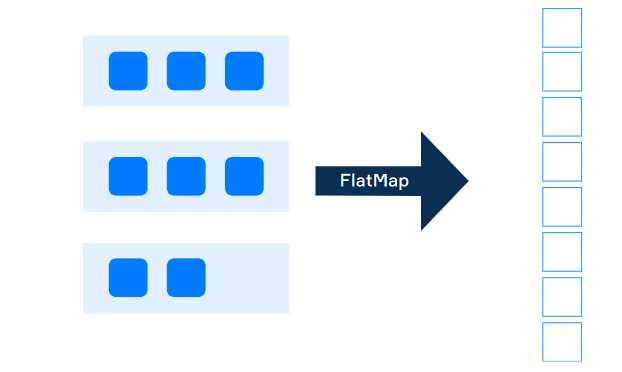Map and FlatMap
One of the most common tasks in programming is converting collections of objects to the new ones by applying the same function to each element in the collection. This task can be solved with a functional approach. Since you already know about Java Stream API, we are ready to take a closer look at the map and flatMap intermediate operations.
The map operation
The map is a method of a Stream class that takes a one-argument function as a parameter. The main purpose of the map operation is to apply that function to each element of the stream and return a resulting stream that has the same amount of elements.
Note that the map is an intermediate operation, which means that it returns a new stream.
Let’s have a look at several examples where we can use the map operation:
- One of the common uses of the
mapoperation is applying a given function to each element of a stream of values.
List<Double> numbers = List.of(6.28, 5.42, 84.0, 26.0);
Let’s divide each number by 2. For that, we can map each element of the stream to the element divided by 2 and collect it to the new list:
List<Double> famousNumbers = numbers.stream()
.map(number -> number / 2) // divide each number in the stream by 2
.collect(Collectors.toList()); // collect transformed numbers to a new list
The resulting list is:
[3.14, 2.71, 42.0, 13.0]
Note, the
mapmethod doesn’t do any evaluations. Each number divided by 2 will be collected to the newfamousNumberslist after callingcollect(Collectors.toList())only.
mapis often used to get a stream of properties from а stream of objects. For example, given a classJob:
public class Job {
private String title;
private String description;
private double salary;
// getters and setters
}
We can get the list of job titles from a given list of jobs by using the map method:
List<String> titles = jobs.stream()
.map(Job::getTitle) // get title of each job
.collect(Collectors.toList()); // collect titles to a new list
The code above will call the method getTitle of each Job object and collect the resulting list to the new one.
- Another common use case is obtaining a list of some objects from the list of other objects. Let’s assume we have the following classes:
class User {
private long id;
private String firstName;
private String lastName;
}
class Account {
private long id;
private boolean isLocked;
private User owner;
}
class AccountInfo {
private long id;
private String ownerFullName;
}
And we would like to get a list of AccountInfo objects from a list of Account objects. We can do it by using the map method:
List<AccountInfo> infoList = accounts.stream()
.map(acc -> {
AccountInfo info = new AccountInfo();
info.setId(acc.getId());
String ownerFirstName = acc.getOwner().getFirstName();
String ownerLastName = acc.getOwner().getLastName();
info.setOwnerFullName(ownerFirstName + " " + ownerLastName);
return info;
}).collect(Collectors.toList());
The code above will map each Account object to the new AccountInfo object and collect it to the new list of AccountInfo objects.
Primitive-specialized types of the map operation
Primitive-specialized streams such as IntStream, LongStream, or DoubleStream also have the map method that maps the primitive value to another primitive of the same type. However, it is useful to have a way to map a primitive value to the object. For that primitive-specialized streams have a mapToObj method.
Let’s consider an example where a class Planet is given:
class Planet {
private String name;
private int orderFromSun;
public Planet(int orderFromSun) {
this.orderFromSun = orderFromSun;
}
}
Now we can map int elements of the IntStream to the stream of objects using mapToObj method and collect the resulting stream to the list of Planet objects:
List<Planet> planets = IntStream.of(1, 2, 3, 4, 5, 6, 7, 8)
.mapToObj(Planet::new)
.collect(Collectors.toList());
The flatMap operation
The map operation works great for streams of primitives and objects, but the input can also be a stream of collections. For example, the method stream() of a List<List<String>> returns a Stream<List<String>>. In that case, we often need to flatten a stream of collections to a stream of elements from these collections.
Flattening refers to merging elements of a list of lists to a single list. For example, if we flatten a
[["a", "b"], ["c"], ["d", "e"]]list of lists, we will get["a", "b", "c", "d", "e"]list.
In such cases, a flatMap method can be useful. It takes and applies a one-argument function in order to transform each stream element into a new stream and concatenates these streams together.
Let’s consider an example with java books. Each book has a title, a publishing year, and a list of authors:
List<Book> javaBooks = List.of(
new Book("Java EE 7 Essentials", 2013, List.of("Arun Gupta")),
new Book("Algorithms", 2011, List.of("Robert Sedgewick", "Kevin Wayne")),
new Book("Clean code", 2014, List.of("Robert Martin"))
);
Now we can obtain a list of all authors from the list of java books by using flatMap method:
List<String> authors = javaBooks.stream()
.flatMap(book -> book.getAuthors().stream())
.collect(Collectors.toList());
The resulting list is:
["Arun Gupta", "Robert Sedgewick", "Kevin Wayne", "Robert Martin"]
Conclusion
The map is an intermediate operation that allows us to apply a given one-argument function to each element of the stream and produce a new stream with the same number of elements. Primitive-specialized streams also have a map method that maps a stream primitive value to another primitive value of the same type. In addition to the map, primitive-specialized streams provide a mapToObj method that produces an object-valued stream. Java Stream API also provides a flatMap method that applies a given function that converts a stream element to the new stream and concatenates all obtained stream to a single one.
